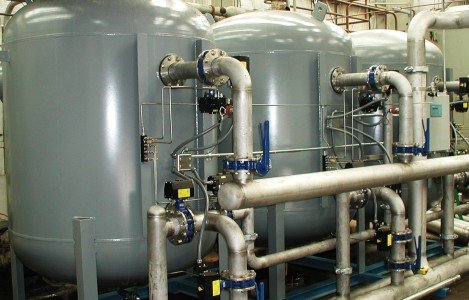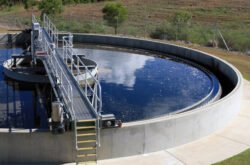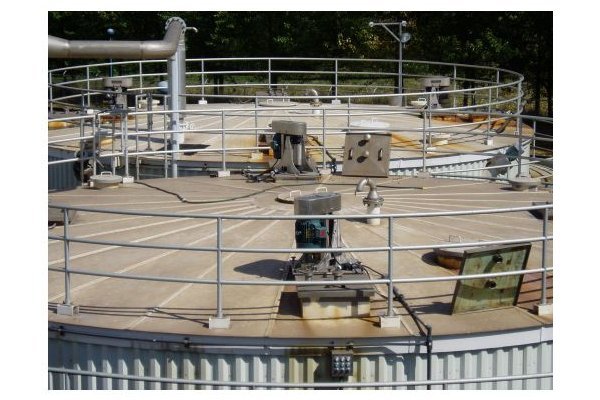Granular Media Filtration in Wastewater Treatment: Enhancing Purification Efficiency

Granular media filtration plays a crucial role in the treatment of wastewater by removing suspended solids and contaminants to improve water quality. This type of filtration utilizes layers of granular materials, such as sand and anthracite, through which the wastewater is passed. The size and type of the granular media, along with the design of the filter system, substantially influence the overall effectiveness of the filtration process. Effective removal of particles not only protects aquatic ecosystems but also ensures that the treated water is safe for various uses, including industrial processes and, potentially, returning it to the natural water cycle.
With increasing global emphasis on environmental impact and sustainability, the operation and maintenance of granular media filtration systems have become essential topics within the wastewater management industry. Innovations and advancements in filtration technology seek to increase efficiency, minimize maintenance costs, and meet stringent regulatory standards. These developments, alongside comprehensive performance assessments, promise to enhance the effectiveness of wastewater treatment while reducing the ecological footprint of such processes.
Key Takeaways
- Granular media filtration is a vital process for improving wastewater quality.
- Recent advancements aim to enhance the efficiency and sustainability of filtration systems.
- Compliance with regulatory standards ensures the safe and effective operation of filtration technologies.
Basics of Granular Media Filtration
Granular media filtration is a critical process in wastewater treatment, designed to remove contaminants through the use of different media types and adherence to physical filtration principles.
Types of Granular Media
Granular media in wastewater treatment are primarily categorized by material and size. Common media types include sand, anthracite, and granular activated carbon (GAC). Each medium has unique properties that determine its appropriateness for different filtration needs. For instance, sand, with its high surface area, is excellent for fine particle retention, whereas anthracite is favored for its durability and good hydraulic characteristics.
Additionally, modified or engineered media exist, such as those used in the TETRA Denite system, which consists of a monomania granular sand with a specific effective size for optimized filtration.
Physical Principles of Filtration
The physical principles of filtration revolve around removing suspended particles from wastewater via mechanical straining, sedimentation, and adsorption. The wastewater is passed through the granular media, where various forces, including Van der Waals forces and electrostatic attraction, help capture and hold the particles.
Media selection and layering are crucial to effectively manage the hydraulic loading rates and to ensure adequate contact time between wastewater and media for optimal contaminant removal. Uniform and relatively spherical media, as stated by some filter manufacturers, promote rolling and enhanced contact with water, thereby increasing treatment efficiency.
Design Considerations for Filtration Systems
When designing granular media filtration systems for wastewater treatment, engineers must prioritize filter media selection and filter bed configuration to optimize contaminant removal and maintain system efficiency.
Filter Media Selection
The choice of filter media is pivotal in determining the effectiveness of a granular media filtration system. Granular activated carbon (GAC) is often employed due to its high adsorptive capacity for removing organic and some inorganic pollutants from wastewater. It is essential to select a media that has been appropriately activated to increase its surface area and enhance its sorptive qualities.
Other media options include sand, anthracite, and dual media filters, which combine layers of sand and anthracite to exploit the different properties of each material. The media’s grain size, uniformity coefficient, and hydraulic conductivity directly impact the filtration rate and efficiency. For example, finer grain size can lead to improved removal of particulates but may also increase the potential for clogging and higher backwash frequencies.
Filter Bed Configuration
The configuration of the filter bed influences the flow dynamics and distribution of wastewater within the system. A typical design consideration involves the influent weir configuration, which must ensure even distribution of wastewater over the filter bed to prevent channeling and uneven filtration. Types of filter media, underdrain systems, and backwashing mechanisms also play a crucial role.
An underdrain system at the bottom of the filter bed collects the filtered water and facilitates periodic backwashing to remove trapped contaminants and prevent media compaction. The system must be designed to support the media weight and provide uniform flow during both filtration and backwashing to maintain operational integrity and prolong the lifespan of the filter media.
Operation and Maintenance
Granular media filtration is essential for treating wastewater effectively. Key operation and maintenance activities ensure the system’s reliability and optimal performance.
Backwashing Procedures
Backwashing is a crucial process where water flows backward through the filter to remove entrapped solids. For efficient backwashing, operators must follow specific steps:
- Cease filtration and close the outlet valves.
- Open backwash water inlet valves to initiate the backwash cycle.
- Monitor the water until it runs clear, indicating that the accumulated solids have been removed.
- Resume normal filtration operation by reverting the valves to their original state.
The frequency of backwashing depends on factors such as water quality and filtration rate. Automated systems usually have pre-set intervals, while manual systems require regular monitoring to determine when backwashing is necessary.
Routine Maintenance Tasks
Routine maintenance tasks are necessary to maintain granular media filtration systems. They include:
- Inspection: Regular visual checks of the filter media and components to identify wear or damage.
- Cleaning: Components, such as pumps and valves, require regular cleaning to prevent clogging and wear.
- Media Replacement: Over time, filter media can degrade. Operators must monitor the media’s condition and schedule replacement when necessary to ensure filtration efficacy.
Operators also need to regularly check for leaks and other signs of system breaches which, if left unattended, can compromise the entire filtration process. Record-keeping of maintenance activities is essential for tracking the system’s performance and planning future maintenance tasks.
Performance and Efficiency Assessment
Assessing the performance and efficiency of Granular Media Filtration in Wastewater Treatment is crucial to determining the quality of water output and the effectiveness of the filtration process. Key factors include measuring the removal of contaminants and dealing with any operational issues that may hinder filtration efficiency.
Measuring Filtration Effectiveness
To measure the effectiveness of granular media filtration, specific parameters must be observed:
- Turbidity: A turbidimeter is used to assess the clarity of water by measuring the amount of suspended particles.
- Particle Count: Measures the concentration of particles of different sizes before and after filtration.
- Effluent Quality: Chemical and microbial analyses are conducted to determine if the treated water meets regulatory standards.
It’s also essential to regularly monitor backwash frequency and media life to ensure the media is functioning optimally, as over-exhausted media will diminish filtration quality.
Troubleshooting Common Issues
Common operational issues that can affect granular media filters include:
- Channeling: Occurs when water forms channels through the media, leading to uneven filtration. This can be identified by inspecting the uniformity of the filter bed after backwashing.
- Media Fouling: Over time, the media can become clogged with organic or inorganic matter. Signs include increased pressure drop across the filter and reduced flow rates.
- Air Binding: This can happen when air gets trapped in the filter bed, reducing the rate of filtration. Ensuring proper backwashing procedures can help prevent this problem.
Regular maintenance and understanding the specific needs of the granular media being used are key to addressing these issues and maintaining filtration effectiveness.
Advancements in Filtration Technology
Recent advancements in filtration technology have significantly augmented the efficiency and effectiveness of granular media filtration in wastewater treatment.
Innovations in Filter Media
Researchers have developed advanced granular media, precisely engineered to target a broader spectrum of contaminants. These include modifications like biologically active media and nano-sized adsorbents. This enhanced media offers increased specificity towards pollutants, resulting in higher removal efficiency. For instance, improvements in clay granules and resin beads have led to a much finer filtration capability.
Automation in Filtration Systems
The integration of automation technology into filtration systems has streamlined wastewater treatment processes. Automation allows for real-time monitoring and adjustments, which are critical for maintaining filtration efficacy and handling fluctuating wastewater qualities. Automated backwashing is a notable innovation that optimizes media cleaning schedules, conserves water, and reduces manual intervention.
Environmental Impact and Sustainability
Granular Media Filtration plays a crucial role in wastewater treatment, contributing significantly to environmental protection by purifying water before release. Implementing sustainable practices in this process reduces both energy use and waste, aligning with broader ecological goals.
Reducing Energy Consumption
Granular media filtration systems can be designed to minimize energy consumption. Traditional filtration methods rely on high-energy input to maintain water flow through the media. However, advancements have led to the development of more efficient systems that reduce the overall energy required for operation. For instance, optimizing the backwashing process can conserve water and energy, as backwashing is a periodic maintenance procedure used to clean the filter media.
Waste Management and Recycling of Spent Media
Once the granular media reaches the end of its useful life, it must be appropriately managed to minimize environmental impact. The sustainability of granular media filtration can be enhanced by recycling spent media. Spent media can often be reprocessed and reused, which not only reduces the demand for new media but also decreases waste sent to landfills. Waste management strategies involving the safe disposal of media that cannot be recycled are essential to mitigate the potential release of accumulated contaminants back into the environment.
Regulatory Standards and Compliance
Granular media filtration is a key process in wastewater treatment, subject to strict regulatory standards to protect public health and water quality. Compliance with these regulations is crucial for treatment facilities to maintain operational permits and prevent environmental contamination.
Local and International Filtration Guidelines
Local guidelines for granular media filtration often align with broader international standards, yet they can vary depending on regional water quality goals and public health requirements. For example, the New York State Department of Environmental Conservation endorses the Ten States Standards as the official criteria for wastewater treatment in New York, including specifications for filtration system design. Internationally, organizations such as the World Health Organization provide guidance, but ultimately, facilities must adhere to their specific national and local regulations.
Ensuring Public Health and Safety
The primary objective of regulatory compliance is to ensure public health and safety through effective wastewater treatment. Protocols for the operation of granular media filtration systems are established to remove pathogens and contaminants consistently, thereby reducing health risks associated with polluted water. Organizations like the US EPA dictate standards for the removal of specific pollutants, such as arsenic, through granular media like ferric oxide or ferric hydroxide, and set forth testing and reporting requirements to confirm filtration systems’ efficiency and safety. Compliance with these standards is not only a legal obligation but a moral imperative to protect ecosystems and public health.
Case Studies and Real-world Applications
In the realm of wastewater treatment, granular media filtration has been implemented successfully in various settings. The following subsections provide a detailed look into specific examples of how this technology has significantly contributed to water purity in both municipal and industrial domains.
Municipal Wastewater Treatment Success Stories
City of Arcata, California: The Arcata Marsh and Wildlife Sanctuary is a pioneering facility that integrates granular media filtration. It utilizes a series of oxidation ponds, constructed wetlands, and sand filters. This approach has remarkably improved the quality of treated wastewater, which is effectively reused for wildlife habitats and public spaces.
Singapore’s NEWater Programme: Granular media filtration is a cornerstone in Singapore’s advanced water reclamation process. The NEWater plants meticulously filter wastewater using granular media before subjecting it to further purification. This results in water that surpasses World Health Organization drinking water standards and contributes to the city-state’s water sustainability efforts.
Industrial Applications of Granular Media Filtration
Waste Walnut Shells for Chromium Removal: An innovative study demonstrated the use of waste walnut shells as a granular media for the adsorptive removal of chromium from industrial effluents. The high surface area of walnut shells makes them effective for capturing and sequestrating heavy metal ions, offering an eco-friendly solution for wastewater treatment.
Optical Lens Manufacturing Effluents: The waste generated in the optical lens manufacturing industry often contains contaminants such as plastics. Employing granular media filtration helps remove these nano- and microplastics, ensuring that the resulting wastewater does not harm aquatic ecosystems when released into the environment.
Future Trends in Wastewater Filtration
Innovation in granular media filtration seeks to enhance efficiency and adapt to varying treatment demands. Anticipated shifts encompass novel methodologies and expanded applications in localized settings.
Emerging Technologies
Granular media filtration is on the cusp of transformation with advanced materials and smart operational algorithms. Researchers are focusing on nano-enhanced media that promise higher pollutant removal rates. They are looking at materials capable of targeting specific contaminants like heavy metals and persistent organic pollutants, offering more specialized and effective treatment solutions.
Another important trend is the integration of real-time monitoring and automated control systems. These advancements employ sensors and IoT technology to adjust filtration parameters dynamically, optimizing performance and resource usage. They can enhance the overall efficiency of wastewater treatment and ensure consistent quality of effluent.
Potential for Decentralized Treatment Systems
Decentralized treatment systems represent a significant shift away from large, centralized facilities. They involve smaller, often community-scale operations that treat wastewater closer to its point of origin. Granular media filtration plays a crucial role in these systems, due to its versatility and ease of implementation.
With the advancement of compact filter designs, these systems are becoming more effective for use in remote locations, urban retrofitting, and emergency response scenarios. They stand out for their potential to reduce infrastructure costs, and their adaptability makes them suitable for a range of environmental conditions and treatment needs.
Frequently Asked Questions
What are the common types of granular filtration media used in wastewater treatment?
Typical granular filtration media used in wastewater treatment include sand, anthracite, and activated carbon. These materials are effective at removing various contaminants from water through physical and to some degree chemical processes.
How does granular media filtration differ from membrane and mechanical filtration methods?
Granular media filtration primarily relies on the physical training and adsorption properties of the media to remove contaminants. In contrast, membrane filtration uses semi-permeable membranes to physically block particles, while mechanical filtration often involves a physical barrier such as a screen or a filter cloth.
Can you outline the process and mechanism of operation for granular media filtration?
In a granular media filtration system, water passes through a bed of granular material, typically arranged in layers of decreasing coarseness from top to bottom. Contaminants are trapped within the interstitial spaces between the grains or adsorbed onto the media's surface, effectively reducing turbidity and improving water quality.
In what ways is granular media filtration applied in water treatment applications?
Granular media filtration is utilized for the removal of suspended solids, organic compounds, and some forms of metals during primary and secondary wastewater treatment. It is also commonly used as a polishing step after biological treatments to further clean the water before disinfection or discharge.
What are the advantages and limitations of using granular media filtration in wastewater treatment?
One of the main advantages of granular media filtration is its cost-effectiveness and simplicity of operation. However, limitations include the need for regular backwashing to remove accumulated contaminants and the potential for media channeling, which can reduce the effectiveness of the filtration process.
How do various forms of granular media determine the efficacy of the filtration process?
The efficacy of the filtration process is governed by the media’s grain size, surface area, and porosity. For example, finer grains generally provide higher removal efficiencies for small particles, while activated carbon is chosen for its high adsorptive capacity for organic contaminants.


